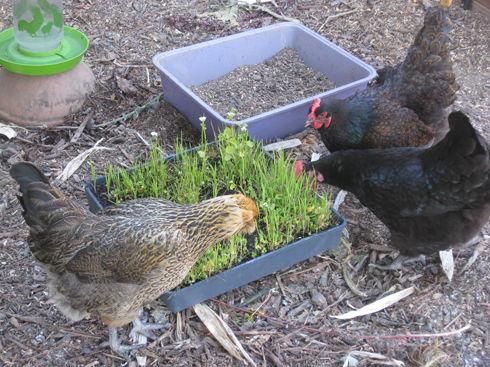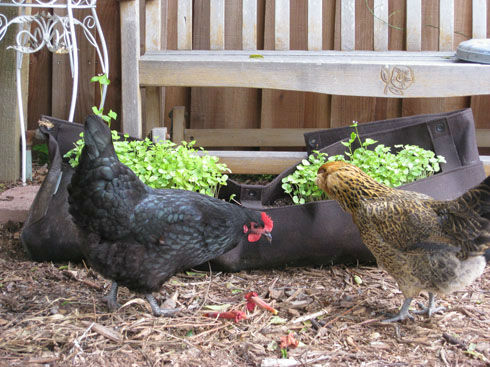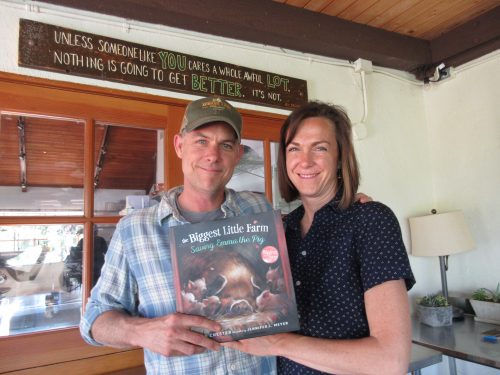Heads-up homesteaders, this Ask Gardenerd question is for you:
“I want to start having my chickens eat things from the earth, than from the store. They are were born in April. I saw your video on YouTube about making that grass cover for them. Do you recommend compost piles and the turf for the chickens? Would you feed them other things as well? Or do you have resources that you think might get us in the right direction. Thank you! You are amazing!” – Jocelyn
Aw, shucks. Thanks, Jocelyn. Great question, BTW, and good for you for wanting to provide homegrown chicken feed on site. Your timing couldn’t be more perfect. Last week, two answers to your question came our way and we’d be happy to share.

<script src=”https://apis.google.com/
<div class=”g-ytsubscribe” data-channel=”Gardenerd1″ data-layout=”default” data-count=”default”></div>
Chickens and compost – in addition to giving your chickens greens from the garden and forage mix in seed flats (as shown above), you can let your chickens loose on your compost bin. Chickens will gobble grubs and other crawlers right up, and they will aerate your compost pile for you in the process. Here’s what you need to know before you do:
Once you introduce fresh chicken manure into the pile, you have to compost that pile again before you can use it in your garden. Dr. Elaine Ingham warns about introducing pathogens into compost piles that are finished and ready to use. So consider giving your chickens an immature pile to rummage through, then move that pile to a bin to finish composting for several months before using it in your garden. Make sure the pile has the proper balance of carbon to nitrogen ingredients (chicken manure is high nitrogen, which helps kick up the heat). Water it well and turn it regularly to keep it aerobic. The manure will break down into a non-pathogenic, safe fertilizer for your garden that your plants will love.
Grubs – as mentioned above, chickens love grubs. We have found that green beetles love to lay their young inside our compost piles. So every time we turn a pile, we unearth at least 50 grubs. We toss them into a bucket and feed them to the chickens over the next few days. Great protein source for your birds. If you find them in your garden soil instead, you can do the same.
More grubs – This tip comes from Erin Regan, a fellow Soil Food Web intensive attendee (who creates amazing furniture & art, BTW). Over lunch one day she told us how she created a “grub station” for her chickens that is about as hands-off as you can get. She took a bucket and drilled small holes in the bottom, and larger holes in the sides, around the top edge. She put a few pieces of animal innards in the bucket (livers, I think) and put a lid on it. She hung the bucket in a tree, 7-8 feet over her chicken run. Flies go in and lay eggs on the meat, grubs crawl out through the holes and drop down to unsuspecting chickens. Erin put something flat on the ground underneath it, like the lid of a Rubbermaid bin, so the chickens would learn to hear the sound of grubs landing on the lid. Genius! She got this idea from Paul Wheaton, I believe. Here is his video showing a similar design.
Sustainable Forage Patch – This last idea comes from an article we saw in Mother Earth News awhile ago. Joel Salatin spotted this technique on a fellow farmer’s homestead and thought it was genius. Build a frame (whatever size you want it to be) with 2×4 wood and cover the frame with hardware cloth. Lay the frame on top of an area that has been seeded with a suitable chicken forage cover crop. Water it regularly.
As it grows, your chickens will only be able to eat the tops of the forage mix, rather than uprooting the whole thing (which is a problem with those forage flats we give them). The frame keeps the hardware cloth about 2-4 inches above the soil (and root system) so the chickens can eat, but not destroy. Here’s a site with plans for building your own. We’ll be trying this one out in our run soon. It also helps prevent erosion, which is an issue in chicken runs with bare soil.
So, Joceyln, try these out and see what works for you. Thanks for writing in!



